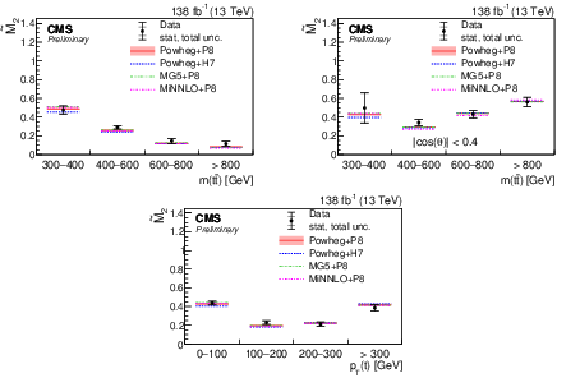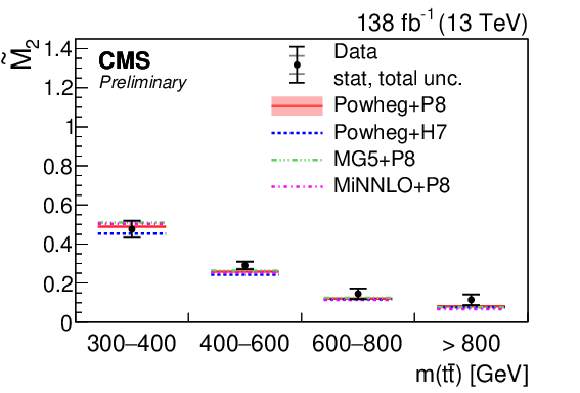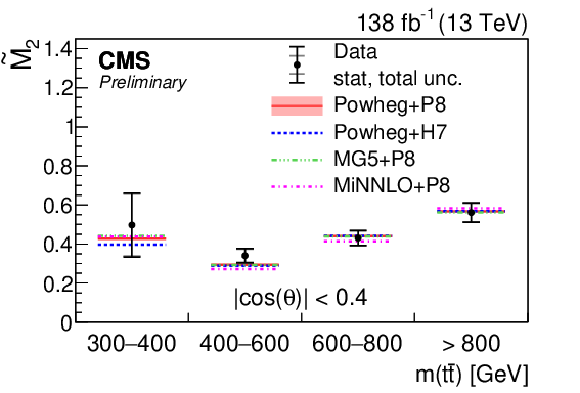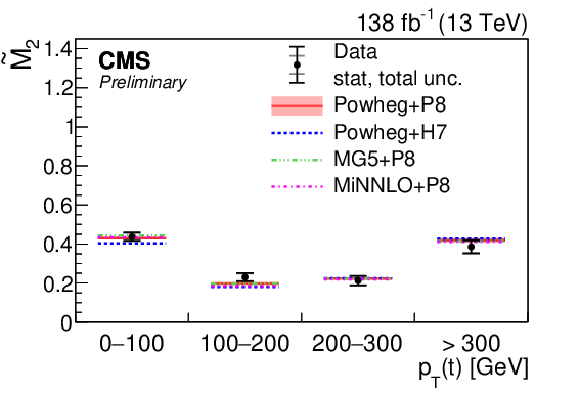

Compact Muon Solenoid
LHC, CERN
| CMS-PAS-TOP-25-001 | ||
| Observation of magic states of top quark pairs produced in proton-proton collisions at $ \sqrt{s}= $ 13 TeV | ||
| CMS Collaboration | ||
| 14 March 2025 | ||
| Abstract: An observation of magic states of top quark-antiquark ($ \mathrm{t\bar{t}} $) systems produced in proton-proton collisions at the LHC at $ \sqrt{s}= $ 13 TeV is presented. Magic, defined here using the second stabilizer Renyi entropy, is an important property used to characterize quantum states in quantum information science. Quantum states with high magic provide computational advantage over classical systems. This observation is based on measurements of the polarization and spin correlation coefficients in $ \mathrm{t\bar{t}} $ systems using the final states with an electron or muon and jets. Magic is determined in various kinematic regions of the $ \mathrm{t\bar{t}} $ system and is found to agree with the standard model predictions. This study represents the first experimental measurement of this quantity at the TeV energy scale. | ||
| Links: CDS record (PDF) ; CADI line (restricted) ; | ||
| Figures | |

png pdf |
Figure 1:
Results of $ \tilde{M}_\mathrm{2} $ measurements in bins of $ m({\mathrm{t}\overline{\mathrm{t}}} ) $ (upper left ), $ m({\mathrm{t}\overline{\mathrm{t}}} ) $ with $ |\cos(\theta)| < $ 0.4 (upper right ), and $ p_{\mathrm{T}}(\mathrm{t}) $ (lower). The measurements (points) are shown with the statistical uncertainty (inner error bars) and total uncertainty (outer error bars) and compared to the predictions of POWHEG + PYTHIA, POWHEG + HERWIG, MADGRAPH5\_aMC@NLO+ PYTHIA, and MINNLO+ PYTHIA. The POWHEG + PYTHIA prediction is displayed with the matrix element scale and parton distribution function uncertainties, while for all other predictions only the central values are indicated. |

png pdf |
Figure 1-a:
Results of $ \tilde{M}_\mathrm{2} $ measurements in bins of $ m({\mathrm{t}\overline{\mathrm{t}}} ) $ (upper left ), $ m({\mathrm{t}\overline{\mathrm{t}}} ) $ with $ |\cos(\theta)| < $ 0.4 (upper right ), and $ p_{\mathrm{T}}(\mathrm{t}) $ (lower). The measurements (points) are shown with the statistical uncertainty (inner error bars) and total uncertainty (outer error bars) and compared to the predictions of POWHEG + PYTHIA, POWHEG + HERWIG, MADGRAPH5\_aMC@NLO+ PYTHIA, and MINNLO+ PYTHIA. The POWHEG + PYTHIA prediction is displayed with the matrix element scale and parton distribution function uncertainties, while for all other predictions only the central values are indicated. |

png pdf |
Figure 1-b:
Results of $ \tilde{M}_\mathrm{2} $ measurements in bins of $ m({\mathrm{t}\overline{\mathrm{t}}} ) $ (upper left ), $ m({\mathrm{t}\overline{\mathrm{t}}} ) $ with $ |\cos(\theta)| < $ 0.4 (upper right ), and $ p_{\mathrm{T}}(\mathrm{t}) $ (lower). The measurements (points) are shown with the statistical uncertainty (inner error bars) and total uncertainty (outer error bars) and compared to the predictions of POWHEG + PYTHIA, POWHEG + HERWIG, MADGRAPH5\_aMC@NLO+ PYTHIA, and MINNLO+ PYTHIA. The POWHEG + PYTHIA prediction is displayed with the matrix element scale and parton distribution function uncertainties, while for all other predictions only the central values are indicated. |

png pdf |
Figure 1-c:
Results of $ \tilde{M}_\mathrm{2} $ measurements in bins of $ m({\mathrm{t}\overline{\mathrm{t}}} ) $ (upper left ), $ m({\mathrm{t}\overline{\mathrm{t}}} ) $ with $ |\cos(\theta)| < $ 0.4 (upper right ), and $ p_{\mathrm{T}}(\mathrm{t}) $ (lower). The measurements (points) are shown with the statistical uncertainty (inner error bars) and total uncertainty (outer error bars) and compared to the predictions of POWHEG + PYTHIA, POWHEG + HERWIG, MADGRAPH5\_aMC@NLO+ PYTHIA, and MINNLO+ PYTHIA. The POWHEG + PYTHIA prediction is displayed with the matrix element scale and parton distribution function uncertainties, while for all other predictions only the central values are indicated. |
| Summary |
| In conclusion, we performed the first evaluation of the generalized magic $ \tilde{M}_\mathrm{2} $ in top quark-antiquark ( $ \mathrm{t} \overline{\mathrm{t}} $) pairs, a property from quantum information science. Magic reflects how far a quantum state is from being efficiently simulated by classical systems, making it an important measure of a state's potential for quantum computational advantages. The observed magic values are in agreement with the standard model expectations. The results underscore the potential of collider experiments as a platform for exploring fundamental aspects of quantum mechanics, including properties like magic, which play a crucial role in quantum computation. Future studies could refine these measurements further and explore their implications for both quantum information science and high-energy physics. |
| References | ||||
| 1 | ATLAS Collaboration | Observation of quantum entanglement with top quarks at the ATLAS detector | Nature 633 (2024) 542 | 2311.07288 |
| 2 | CMS Collaboration | Observation of quantum entanglement in top quark pair production in proton-proton collisions at $ \sqrt{s}= $ 13 TeV | Reports on Progress in Physics 87 (2024) 117801 | CMS-TOP-23-001 2406.03976 |
| 3 | CMS Collaboration | Measurements of polarization and spin correlation and observation of entanglement in top quark pairs using lepton$+$jets events from proton-proton collisions at $ \sqrt{s}=$ 13 TeV | PRD 110 (2024) 112016 | CMS-TOP-23-007 2409.11067 |
| 4 | M. A. Nielsen and I. L. Chuang | Quantum Computation and Quantum Information | Cambridge University Press, ISBN~978-0-521-63503-5, 2012 link |
|
| 5 | P. W. Shor | Polynomial time algorithms for prime factorization and discrete logarithms on a quantum computer | SIAM J. Sci. Statist. Comput. 26 (1997) 1484 | quant-ph/9508027 |
| 6 | P. W. Shor | Algorithms for quantum computation: discrete logarithms and factoring | in Proceedings 35th Annual Symposium on Foundations of Computer Science, 1994 link |
|
| 7 | L. K. Grover | A fast quantum mechanical algorithm for database search | in Proceedings of the Twenty-Eighth Annual ACM Symposium on Theory of Computing, STOC '96, 1996 link |
|
| 8 | L. K. Grover | Quantum mechanics helps in searching for a needle in a haystack | PRL 79 (1997) 325 | quant-ph/9706033 |
| 9 | D. Gottesman | The Heisenberg representation of quantum computers | in 22nd International Colloquium on Group Theoretical Methods in Physics, 1998 | quant-ph/9807006 |
| 10 | K. Goto, T. Nosaka, and M. Nozaki | Probing chaos by magic monotones | PRD 106 (2022) 126009 | 2112.14593 |
| 11 | L. Leone, S. F. E. Oliviero, Y. Zhou, and A. Hamma | Quantum Chaos is Quantum | Quantum 5 453, 2021 link |
2102.08406 |
| 12 | C. D. White, C. Cao, and B. Swingle | Conformal field theories are magical | Phys. Rev. B 103 (2021) 075145 | 2007.01303 |
| 13 | Z.-W. Liu and A. Winter | Many-Body Quantum Magic | PRX Quantum 3 (2022) 020333 | 2010.13817 |
| 14 | A. Gu, S. F. E. Oliviero, and L. Leone | Doped stabilizer states in many-body physics and where to find them | Phys. Rev. A 110 (2024) 062427 | 2403.14912 |
| 15 | S. F. E. Oliviero, L. Leone, and A. Hamma | Magic-state resource theory for the ground state of the transverse-field Ising model | Phys. Rev. A 106 (2022) 042426 | 2205.02247 |
| 16 | D. Rattacaso, L. Leone, S. F. E. Oliviero, and A. Hamma | Stabilizer entropy dynamics after a quantum quench | Phys. Rev. A 108 (2023) 042407 | 2304.13768 |
| 17 | P. S. Tarabunga, E. Tirrito, T. Chanda, and M. Dalmonte | Many-Body Magic Via Pauli-Markov Chains\textemdashFrom Criticality to Gauge Theories | PRX Quantum 4 (2023) 040317 | 2305.18541 |
| 18 | S. Zhou, Z. Yang, A. Hamma, and C. Chamon | Single T gate in a Clifford circuit drives transition to universal entanglement spectrum statistics | SciPost Phys. 9 (2020) 087 | |
| 19 | A. Gu, S. F. E. Oliviero, and L. Leone | Magic-induced computational separation in entanglement theory | 2403.19610 | |
| 20 | S. Cepollaro et al. | Stabilizer entropy of quantum tetrahedra | PRD 109 (2024) 126008 | 2402.07843 |
| 21 | L. Leone, S. F. E. Oliviero, and A. Hamma | Stabilizer Rényi Entropy | PRL 128 (2022) 050402 | 2106.12587 |
| 22 | C. D. White and M. J. White | Magic states of top quarks | PRD 110 (2024) 116016 | 2406.07321 |
| 23 | P. Nason | A new method for combining NLO QCD with shower Monte Carlo algorithms | JHEP 11 (2004) 040 | hep-ph/0409146 |
| 24 | S. Frixione, P. Nason, and C. Oleari | Matching NLO QCD computations with parton shower simulations: the POWHEG method | JHEP 11 (2007) 070 | 0709.2092 |
| 25 | S. Frixione, G. Ridolfi, and P. Nason | A positive-weight next-to-leading-order Monte Carlo for heavy flavour hadroproduction | JHEP 09 (2007) 126 | 0707.3088 |
| 26 | T. Sjöstrand et al. | An introduction to PYTHIA8.2 | Comput. Phys. Commun. 191 (2015) 159 | 1410.3012 |
| 27 | CMS Collaboration | Extraction and validation of a new set of CMS PYTHIA8 tunes from underlying-event measurements | EPJC 80 (2020) 4 | CMS-GEN-17-001 1903.12179 |
| 28 | M. Bähr et al. | HERWIG++ physics and manual | EPJC 58 (2008) 639 | 0803.0883 |
| 29 | CMS Collaboration | Development and validation of HERWIG 7 tunes from CMS underlying-event measurements | EPJC 81 (2021) 312 | CMS-GEN-19-001 2011.03422 |
| 30 | J. Alwall et al. | The automated computation of tree-level and next-to-leading order differential cross sections, and their matching to parton shower simulations | JHEP 07 (2014) 079 | 1405.0301 |
| 31 | R. Frederix and S. Frixione | Merging meets matching in MC@NLO | JHEP 12 (2012) 061 | 1209.6215 |
| 32 | J. Mazzitelli et al. | Next-to-next-to-leading order event generation for top-quark pair production | PRL 127 (2021) 062001 | 2012.14267 |

|
Compact Muon Solenoid LHC, CERN |

|

|

|

|

|

|